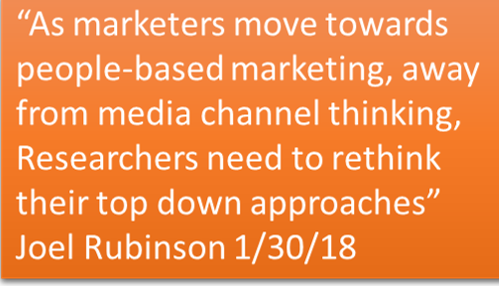Here are four marketing trends…all interconnected…for which research and analytics teams need to plan.
The rise of journey-based marketing. Marketers are moving towards people based marketing and away from channel based marketing. This makes intuitive sense: as a consumer moves through different need states along their journey…from user to shopper to buyer and back to user…their receptivity to different types of messages will change. Fueled by customer databases, unified IDs in advertising DMPs, and intender segments offered by the digital ecosystem, this is now something marketers can act on, delivering the right content and message across screens and across time to an individual consumer. But to really pull this off, we need to bridge marketing silos and bring together advertising, website content, e-mail and social and use the consumer as our new organizing principle.
Researcher implications. Journey based thinking requires that you understand and intersect perspectives: brand and consumer, customer experience, media, and shopper…because these are all phases people go through on their journeys. However, I find that individual researchers tend to specialize in only one area. I find that marketer side insights teams often have blindspots about media, especially the complexity of digital and its data and analytics ecosystem. Media companies often have blindspots about consumer, brand, and shopper research. Every research team needs expertise across all these areas.
Move beyond qualitative journey mapping and set up an experiment to prove that delivering the right message at the right time really does substantially lift marketing ROI and improves the customer relationship. In CPG I was involved in such an experiment. Working with Viant and NCS, we found that targeting people who have a high probability of being close to an upcoming category purchase doubles return on ad spend regardless of creative. When you quantify journeys, you will realize a simple and powerful truth: for any product or service, consumers are either active or dormant and selectively targeting messages to active consumers will turbo charge your marketing ROI.
The blending of retail and marketing. The power of marketing to someone who is ready to buy reveals the reason that Amazon, Walmart, and a few other retailers will generate big digital advertising revenues. Yes, retailers are becoming publishers and ad networks! They have the data to sense if someone is active or dormant, to follow IDs persistently through time and across devices, and to establish ad networks to reach them. Amazon (currently generating billions in ad revenues) is already well along this path.
Researcher implication: Create a plan to understand the effectiveness of advertising via retailers as publishers. Create experiments, using digital data and surveys for measurement of short term and brand equity effects.
The rise of user level analytics. Marketing/media Mix regression models, marketers’ main way of determining what marketing expenditures are working, literally do not have the consumer in the equation so ultimately they fall short. You need user level data and analytics.
Researcher implication: Experiment with and onboard Multi-touch attribution (MTA), which is user-based analysis of media tactics’ effectiveness. You will need unified IDs in your DMP to make MTA valuable, but these platforms are now readily available. MTA advantages: uses current data (not historical); accommodates many more variables…hundreds even…so you can get to a level of granularity that MMM cannot offer, revealing hidden gems…such as discovering that programmatically targeting the right consumers generates more impact that publishers who charge much higher CPMs (real example). Note that MTA can be hard. However, working with the MMA as their SME in this area, I have helped create a whole series of MTA demystification and acceleration tools that can help.
Secondly, connect any surveys you do to your digital data assets so you can create high performing segments and then model them up to scale in your DMP.
The battle between performance and brand marketing intensifies. Brand marketers will fight back against funds being increasingly allocated to what drives short term results. They will ask, “But what about the long-term health of the brand?” However, the counter-argument is that it is possible that performance marketing can also build brands as any purchase or customer acquisition leads to a series of brand experiences.
Researcher implications: Go beyond your dusty brand trackers. Create a brand KPI system that integrates tracker data, digital signals, customer data, and social media. If the brand remains healthy as the budget shifts to higher performing media, then keep going. Of course, if a brand is consistently declining, the solution is not media optimization and then a full-scale brand review is needed.
The common element in all these trends is “performance”…striving for new people-based marketing actions that lead to better outcomes. Marketing researchers: be in the business of generating analyses that lead to new actions, and in turn, lead to better performance in the short and long run. Insights that don’t meet this test are empty calories in a performance environment.


great advice Joel! You Rock!
marketing has always focused on the consumer strategically but also has to focus on the aggregate to manage their P&L over time and to their share holders. A dualistic, unified approach to marketing mix and media attribution achieves both objectives of micro marketing and macro management. I especially your focus on purchase readiness and purchase cycles increasing medias effectiveness the closer to the purchase cycle which is also a key Hendry principle. Keep up the good work.
thanks Art! Truths from Hendry and Erwin Ephron (recency) are still true, only now, with precision targeting in a digital age, we can do something about it!